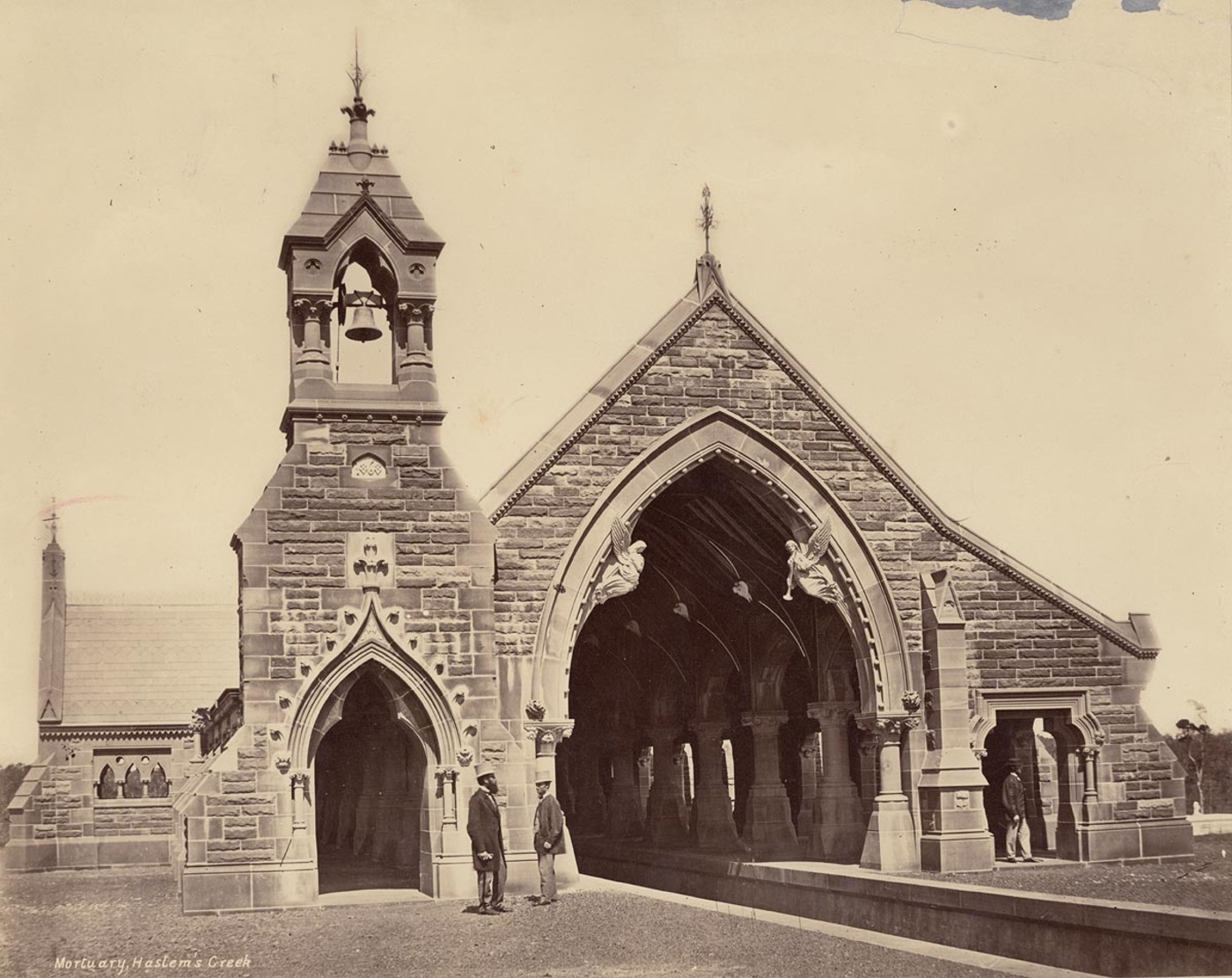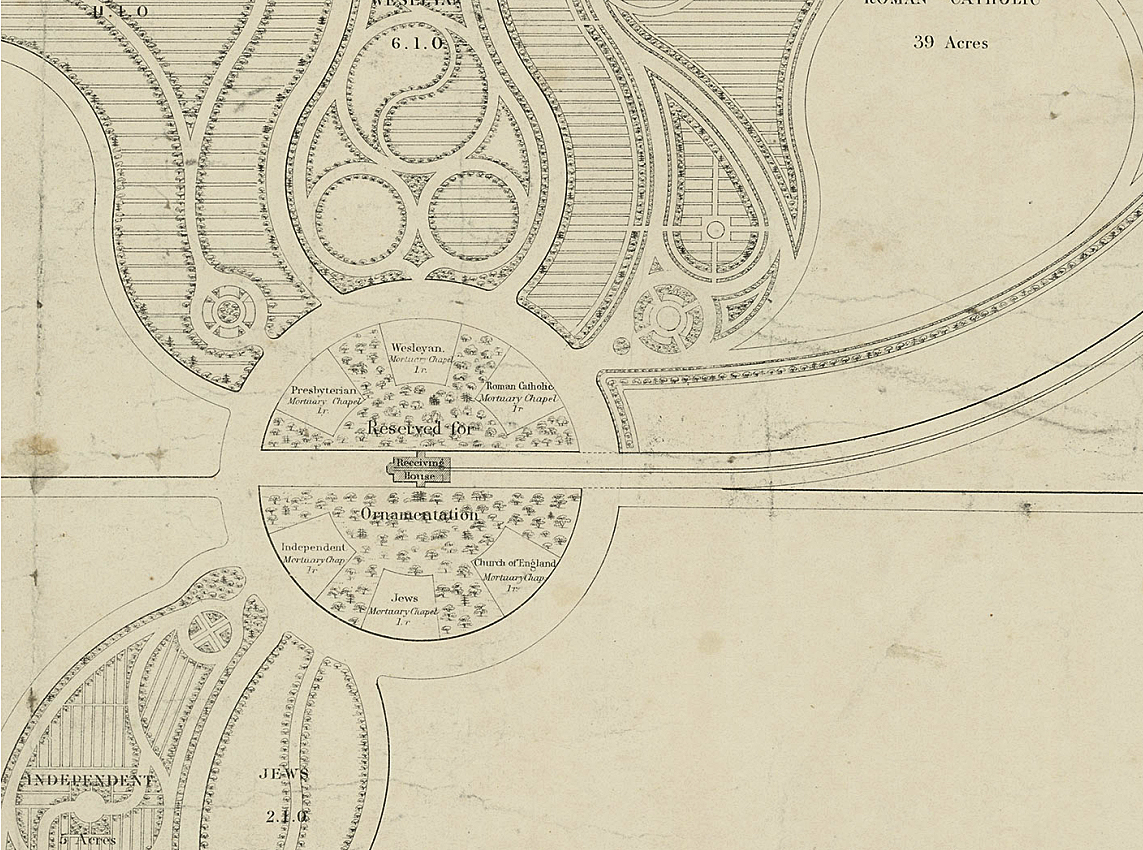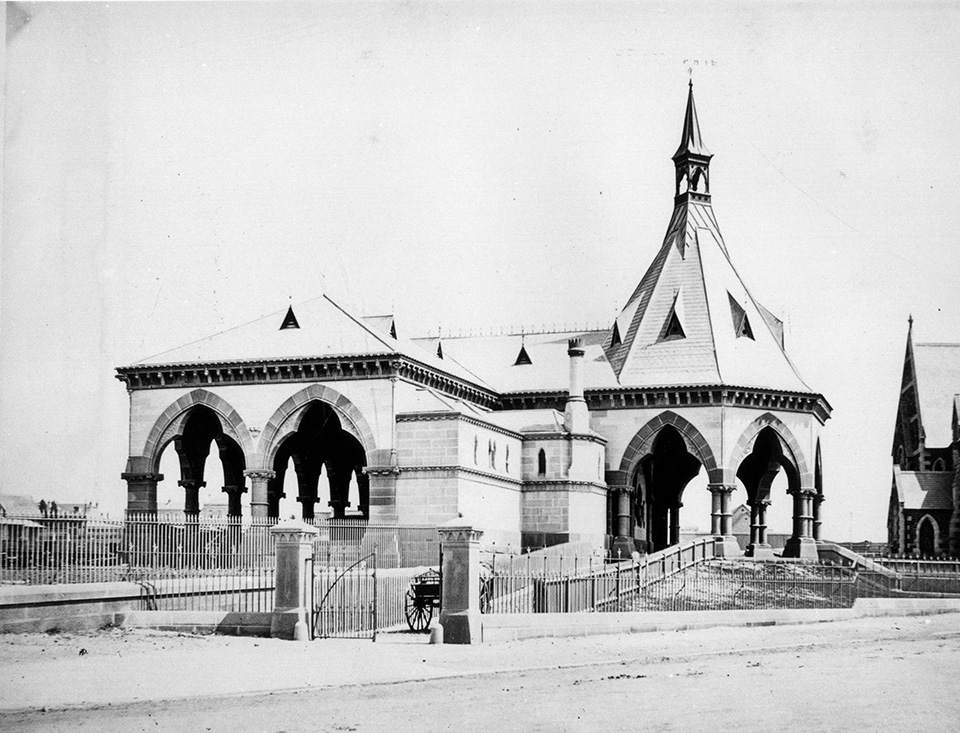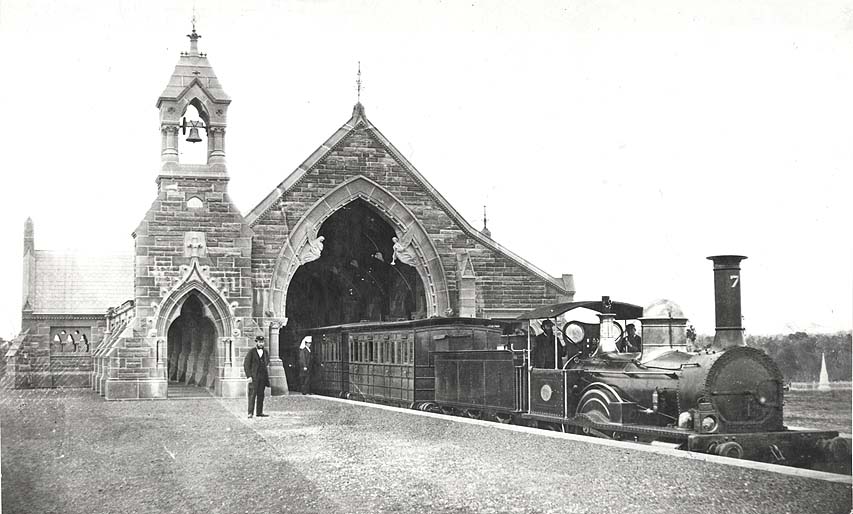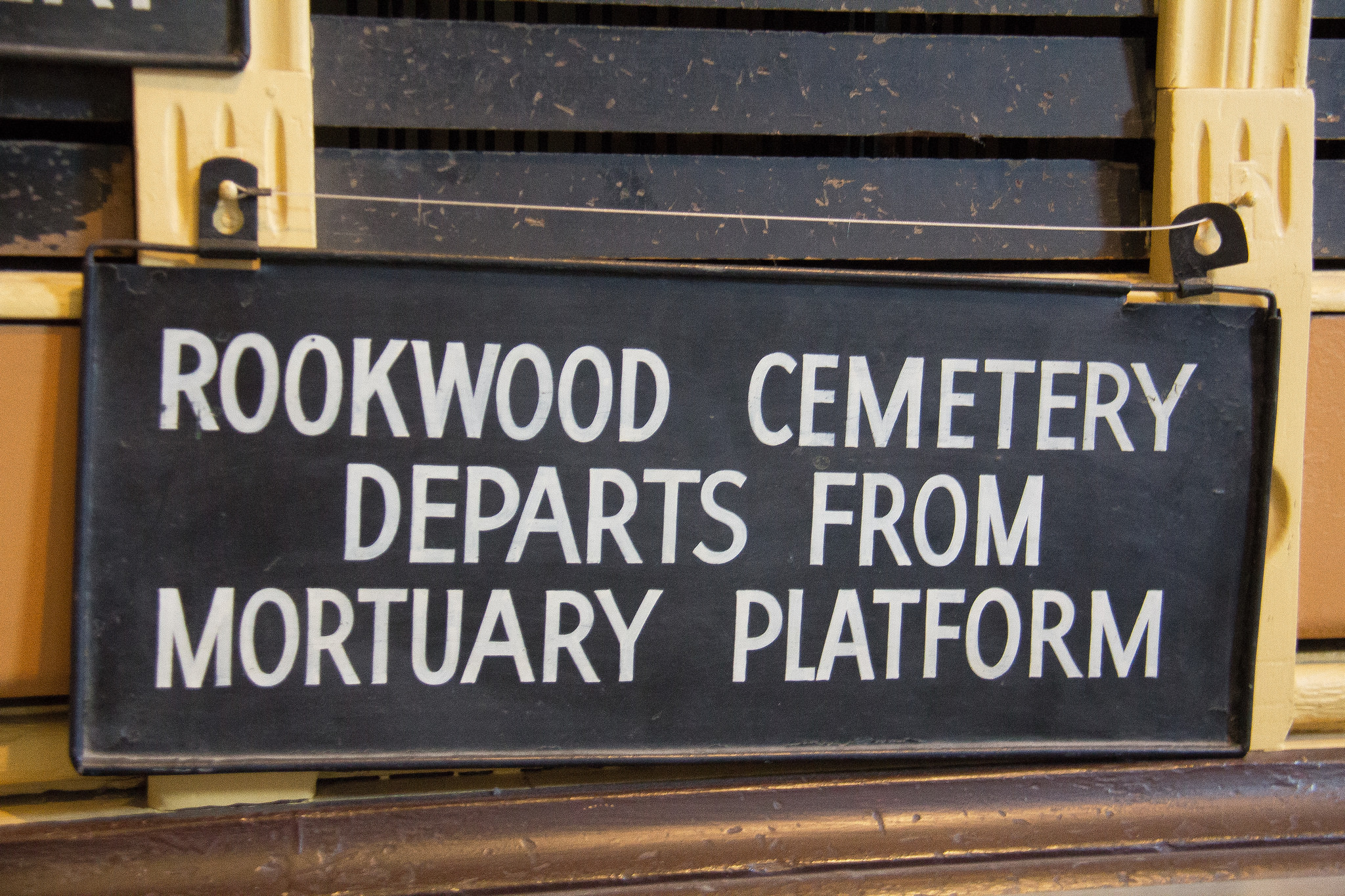The Dictionary of Sydney was archived in 2021.
Funeral trains
Citation
Persistent URL for this entry
To cite this entry in text
To cite this entry in a Wikipedia footnote citation
To cite this entry as a Wikipedia External link
Funeral trains
In an era when walking was the only practical means of travel for many, while the few maintained their own horses and carriages for longer journeys, the arrival of steam trains and trams opened new opportunities for people to travel. One such journey was to the local cemetery to bury loved ones.
[media]By the 1840s, Sydney's main cemetery at Devonshire Street adjacent to Redfern Station was nearing capacity, so planning commenced for a new cemetery to meet the needs of the growing city. With the opening of the railway from Sydney to Parramatta in 1855, it was decided to locate the new facility adjacent to that line. In 1862, the government purchased nearly 200 acres of land (80 hectares) at Haslems Creek on the estate of Edward Cohen, with a further 580 acres (233 hectares) of the estate being purchased in 1879. [1]
Originally known as Haslems Creek Necropolis, the name of the area was changed to Rookwood in 1879 and the cemetery also became known by this name. From 1867, a branch from the main line brought mourners and coffins into the Rookwood Necropolis. Grand sandstone mortuary stations at both ends of the journey served the special funeral trains through to 1948, by which time the journey had given way to road transport. Rookwood Necropolis is recognised as the largest cemetery in the southern hemisphere.
The stations
[media]The two mortuary stations were handsome stone buildings designed in the gothic revival style by the Colonial Architect James Barnet. As they neared completion in April 1868, The Sydney Morning Herald was impressed by the manner in which their gothic style had been adapted to modern circumstances:
The Redfern station, which is situated between the present station yard and Botany-street, is an instance of the Venetian Gothic. The ornamentation is in complete keeping with the style, and great care has been taken not only to secure good workmanship, but good material. Great discrimination has been observed in the choice of the stone, and the individual character of each stone. The whole of the building below the roof is of Pyrmont stone, of two varieties of colour. The building consists of three parts: (1) The entrance portico; (2) The office and waiting rooms; (3.) The main building covering the iron way and the platform. The latter is in the form of a parallelogram, 98 feet 3 inches long by 29 feet wide.
[media]The receiving-house at Haslem Creek is placed in the centre of the 200 acres set apart for the cemetery, and also in the centre of an inner ring comprising 20 acres. The chapels to be erected by the several denominations will be around it. This building is a true specimen of the Italian Gothic style, beautiful in proportion and ornamentation. It is a parallelogram, 98 feet 6 inches by 42 feet. … The sides of the building are entirely open. The rails will run through the nave, the side aisles and a portion of the nave forming platforms. [2]
[media]The Redfern Mortuary Station featured an open turret which housed the funeral bell and was capped by a copper spire and ornamental vane. [3]
The grand stone station for the dead contrasted dramatically with the lowly status of the old Redfern station. This brought public agitation for a new building, particularly after newspaper columnists had a field day, pointing out that train travellers had to make do with a 'tin shed' as their terminus, while the dead were treated to a grand station. The Sydney Morning Herald dubbed the station:
The present station, so far from being ornamental, is seen to most advantage when it is pitch dark. It is the ugliest and least commodious structure on the line, and is always a subject of scornful comparison by visitors from the neighbouring colonies. Probably there is not such another metropolitan station to be found in the world. [4]
As new sections of the cemetery were opened, the stone at the rear of the Receiving House was removed to enable the branch line to be extended to serve the new areas. Rookwood Station 2 comprised a platform, while number 3 had a substantial platform building that incorporated stone from the original 'receiving house'. Rookwood Station 4 also had an elegant platform brick building.
The trains
[media]The funeral trains comprised suburban saloon carriages for the mourners with hearse carriages at the rear. These were either four-wheel vans which could carry up to 10 coffins, or bogie vans with a capacity of up to 30 coffins. On arrival at the Rookwood terminus, the coffins were unloaded using wheeled hand-propelled litters.
Funeral trains were timetabled to depart from Mortuary Station about 9.30 am and 2.30 pm, picking up mourners and coffins as required along the route. As the Rookwood Necropolis expanded, three additional receiving stations were established to take coffins and mourners to newly established sections of the cemetery.
[media]Actual funeral trains ceased in the 1930s, after which trains ran only on Sundays and Mother's Day for visitors. Regular services were revived briefly during World War II and the last timetabled train ran in 1947. The service was officially terminated on 3 April 1948. [5]
Funeral trains also operated on the Illawarra Line from 1900 to a dedicated station within Woronora Cemetery at Sutherland. These trains used the platforms at Sydney Terminal Station rather than Mortuary Station and were available to general commuters.
Today's heritage
Following closure of the branch line, the track was taken up leaving the Necropolis stations abandoned. The Australian Railway Historical Society sought to save the stations. The original 'receiving station' was dismantled and, together with the stone from station number 3, moved to the Canberra suburb of Ainslie in 1957. Here the components were re-erected for All Saints Church of England, which was formally opened on 1 June 1958.
The NSW State Heritage Register listed Mortuary Station in Regent Street was restored by the State Rail Authority from 1981 and was formally re-opened by the premier Neville Wran on 21 April 1985. [6]
Further reading
Mortuary Railway Station and Gardens. NSW Office of Environment and Heritage, State Heritage Register. http://www.environment.nsw.gov.au/heritageapp/ViewHeritageItemDetails.aspx?ID=4803219, viewed 17 February, 2016.
The Woronora Cemetery Branch Line. Peter Neve, ARHS Bulletin, Vol 44 No 670, August 1993, 187-195
Notes
[1] 'The Development of Rookwood Cemetery,' Rookwood Anglican & General Cemeteries, http://www.rookwoodcemetery.com.au/index.php/about-rookwood/history-of-rookwood/the-development-of-rookwood-cemetery, viewed 17 February 2016
[2] Sydney Morning Herald, Thursday 9 April 1869, 5
[3] Illustrated Sydney News, Wednesday 29 September, 263
[4] Sydney Morning Herald, Thursday 1 October 1869, 4
[5] Working timetable, Australian Railway Historical Society NSW branch Resource Centre
[6] Mortuary Railway Station and Gardens, NSW Office of Environment and Heritage, State Heritage Register, http://www.environment.nsw.gov.au/heritageapp/ViewHeritageItemDetails.aspx?ID=4803219, viewed 17 February, 2016
.




